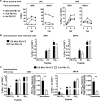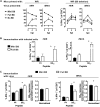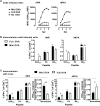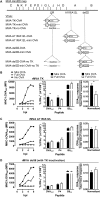Modified Vaccinia Virus Ankara Can Induce Optimal CD8+ T Cell Responses to Directly Primed Antigens Depending on Vaccine Design
- PMID: 31375596
- PMCID: PMC6803277
- DOI: 10.1128/JVI.01154-19
Modified Vaccinia Virus Ankara Can Induce Optimal CD8+ T Cell Responses to Directly Primed Antigens Depending on Vaccine Design
Abstract
A variety of strains of vaccinia virus (VACV) have been used as recombinant vaccine vectors with the aim of inducing robust CD8+ T cell immunity. While much of the pioneering work was done with virulent strains, such as Western Reserve (WR), attenuated strains such as modified vaccinia virus Ankara (MVA) are more realistic vectors for clinical use. To unify this literature, side-by-side comparisons of virus strains are required. Here, we compare the form of antigen that supports optimal CD8+ T cell responses for VACV strains WR and MVA using equivalent constructs. We found that for multiple antigens, minimal antigenic constructs (epitope minigenes) that prime CD8+ T cells via the direct presentation pathway elicited optimal responses from both vectors, which was surprising because this finding contradicts the prevailing view in the literature for MVA. We then went on to explore the discrepancy between current and published data for MVA, finding evidence that the expression locus and in some cases the presence of the viral thymidine kinase may influence the ability of this strain to prime optimal responses from antigens that require direct presentation. This extends our knowledge of the design parameters for VACV vectored vaccines, especially those based on MVA.IMPORTANCE Recombinant vaccines based on vaccinia virus and particularly attenuated strains such as MVA are in human clinical trials, but due to the complexity of these large vectors much remains to be understood about the design parameters that alter their immunogenicity. Previous work had found that MVA vectors should be designed to express stable protein in order to induce robust immunity by CD8+ (cytotoxic) T cells. Here, we found that the primacy of stable antigen is not generalizable to all designs of MVA and may depend where a foreign antigen is inserted into the MVA genome. This unexpected finding suggests that there is an interaction between genome location and the best form of antigen for optimal T cell priming in MVA and thus possibly other vaccine vectors. It also highlights that our understanding of antigen presentation by even the best studied of vaccine vectors remains incomplete.
Keywords: CD8+ T cells; CTL; MVA; antigen presentation; antigen processing; cytotoxic T cells; live vector vaccines; modified vaccinia virus Ankara; vaccinia virus.
Copyright © 2019 Wong et al.
Figures







Similar articles
-
Immediate-early expression of a recombinant antigen by modified vaccinia virus ankara breaks the immunodominance of strong vector-specific B8R antigen in acute and memory CD8 T-cell responses.J Virol. 2010 Sep;84(17):8743-52. doi: 10.1128/JVI.00604-10. Epub 2010 Jun 10. J Virol. 2010. PMID: 20538860 Free PMC article.
-
Expanding the repertoire of Modified Vaccinia Ankara-based vaccine vectors via genetic complementation strategies.PLoS One. 2009;4(5):e5445. doi: 10.1371/journal.pone.0005445. Epub 2009 May 6. PLoS One. 2009. PMID: 19421328 Free PMC article.
-
Enhanced CD8+ T cell immune response against a V3 loop multi-epitope polypeptide (TAB13) of HIV-1 Env after priming with purified fusion protein and booster with modified vaccinia virus Ankara (MVA-TAB) recombinant: a comparison of humoral and cellular immune responses with the vaccinia virus Western Reserve (WR) vector.Vaccine. 2001 Dec 12;20(5-6):961-71. doi: 10.1016/s0264-410x(01)00389-9. Vaccine. 2001. PMID: 11738764
-
Vaccinia vectors as candidate vaccines: the development of modified vaccinia virus Ankara for antigen delivery.Curr Drug Targets Infect Disord. 2003 Sep;3(3):263-71. doi: 10.2174/1568005033481123. Curr Drug Targets Infect Disord. 2003. PMID: 14529359 Review.
-
Modified Vaccinia virus Ankara: innate immune activation and induction of cellular signalling.Vaccine. 2013 Sep 6;31(39):4231-4. doi: 10.1016/j.vaccine.2013.03.017. Epub 2013 Mar 21. Vaccine. 2013. PMID: 23523404 Review.
Cited by
-
Surprisingly Effective Priming of CD8+ T Cells by Heat-Inactivated Vaccinia Virus Virions.J Virol. 2020 Sep 29;94(20):e01486-20. doi: 10.1128/JVI.01486-20. Print 2020 Sep 29. J Virol. 2020. PMID: 32759313 Free PMC article.
-
Sequestration of Late Antigens Within Viral Factories Impairs MVA Vector-Induced Protective Memory CTL Responses.Front Immunol. 2019 Dec 4;10:2850. doi: 10.3389/fimmu.2019.02850. eCollection 2019. Front Immunol. 2019. PMID: 31867011 Free PMC article.
-
A protective bivalent vaccine against Rift Valley fever and bluetongue.NPJ Vaccines. 2020 Jul 30;5(1):70. doi: 10.1038/s41541-020-00218-y. eCollection 2020. NPJ Vaccines. 2020. PMID: 32793399 Free PMC article.
-
Expression of NAC1 Restrains the Memory Formation of CD8+ T Cells during Viral Infection.Viruses. 2022 Aug 4;14(8):1713. doi: 10.3390/v14081713. Viruses. 2022. PMID: 36016335 Free PMC article.
-
The purinergic receptor P2X7 as a modulator of viral vector-mediated antigen cross-presentation.Front Immunol. 2024 Apr 22;15:1360140. doi: 10.3389/fimmu.2024.1360140. eCollection 2024. Front Immunol. 2024. PMID: 38711513 Free PMC article.
References
-
- Qiu J, Peng S, Ma Y, Yang A, Farmer E, Cheng MA, Roden RBS, Wu TC, Chang Y-N, Hung C-F. 2018. Epithelial boost enhances antigen expression by vaccinia virus for the generation of potent CD8+ T cell-mediated antitumor immunity following DNA priming vaccination. Virology 525:205–215. doi:10.1016/j.virol.2018.09.019. - DOI - PMC - PubMed
-
- Marin-Lopez A, Calvo-Pinilla E, Barriales D, Lorenzo G, Brun A, Anguita J, Ortego J. 2018. CD8 T cell responses to an immunodominant epitope within the nonstructural protein NS1 provide wide immunoprotection against bluetongue virus in IFNAR–/– mice. J Virol 92. doi:10.1128/JVI.00938-18. - DOI - PMC - PubMed
-
- Asbach B, Kibler KV, Köstler J, Perdiguero B, Yates NL, Stanfield-Oakley S, Tomaras GD, Kao S-F, Foulds KE, Roederer M, Seaman MS, Montefiori DC, Parks R, Ferrari G, Forthal DN, Phogat S, Tartaglia J, Barnett SW, Self SG, Gottardo R, Cristillo AD, Weiss DE, Galmin L, Ding S, Heeney JL, Esteban M, Jacobs BL, Pantaleo G, Wagner R. 2018. Priming with a potent HIV-1 DNA vaccine frames the quality of immune responses prior to a poxvirus and protein boost. J Virol 93:e01529-18. doi:10.1128/JVI.01529-18. - DOI - PMC - PubMed
-
- Marlin R, Nugeyre M-T, Tchitchek N, Parenti M, Hocini H, Benjelloun F, Cannou C, Dereuddre-Bosquet N, Levy Y, Barré-Sinoussi F, Scarlatti G, Le Grand R, Menu E. 2017. Modified vaccinia virus Ankara vector induces specific cellular and humoral responses in the female reproductive tract, the main HIV portal of entry. J Immunol 199:1923–1932. doi:10.4049/jimmunol.1700320. - DOI - PubMed
Publication types
MeSH terms
Substances
LinkOut - more resources
Full Text Sources
Research Materials

